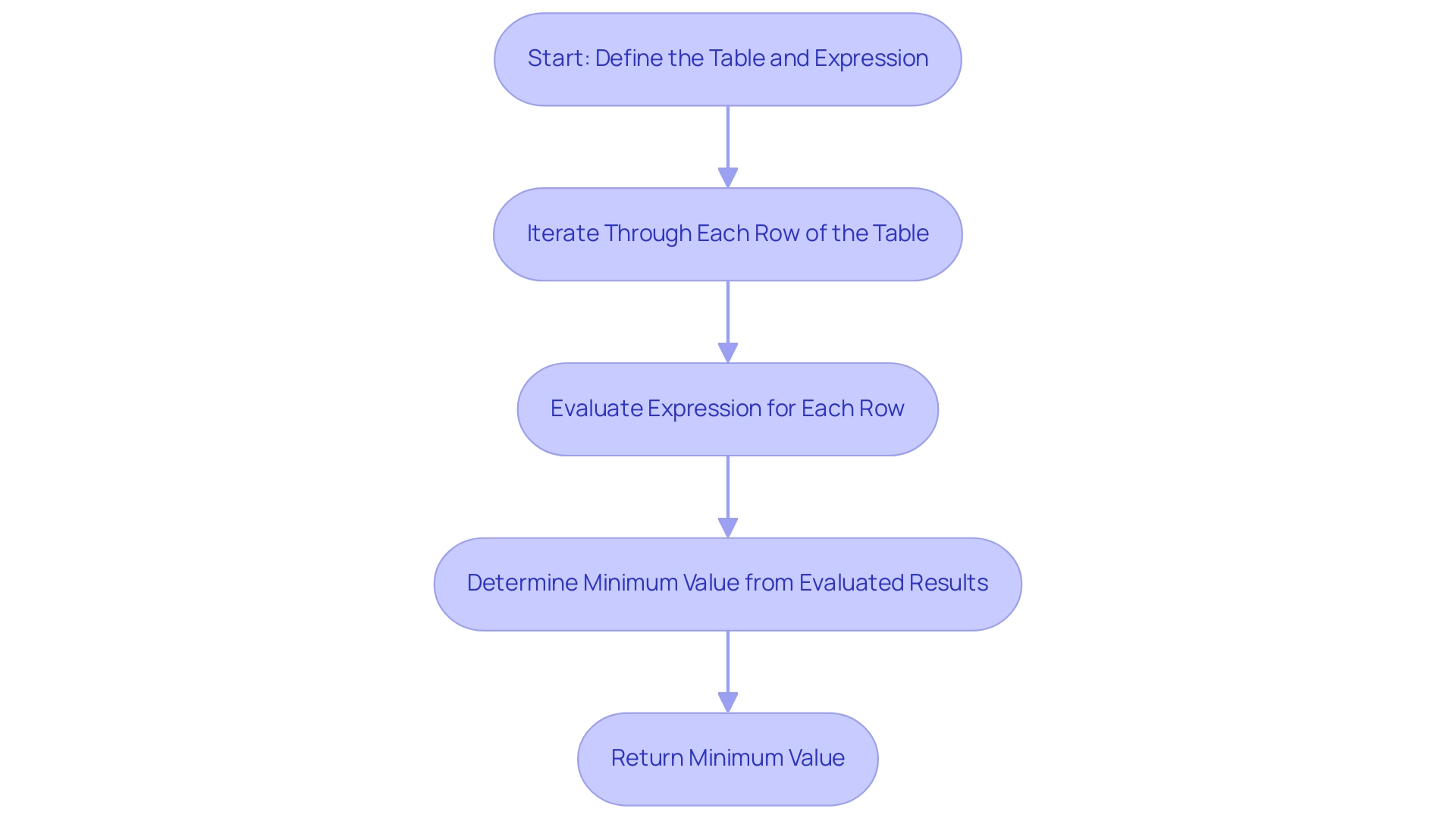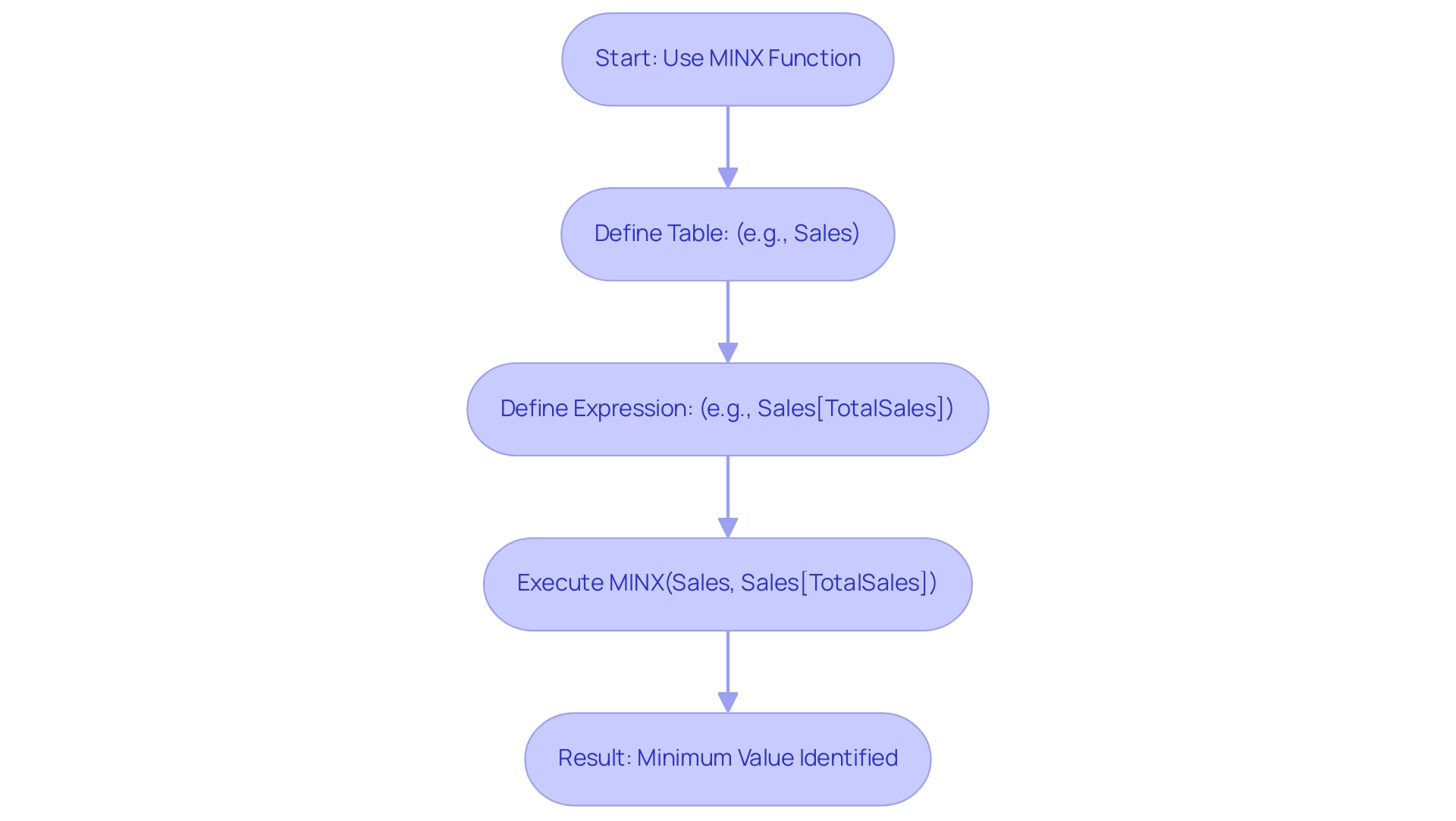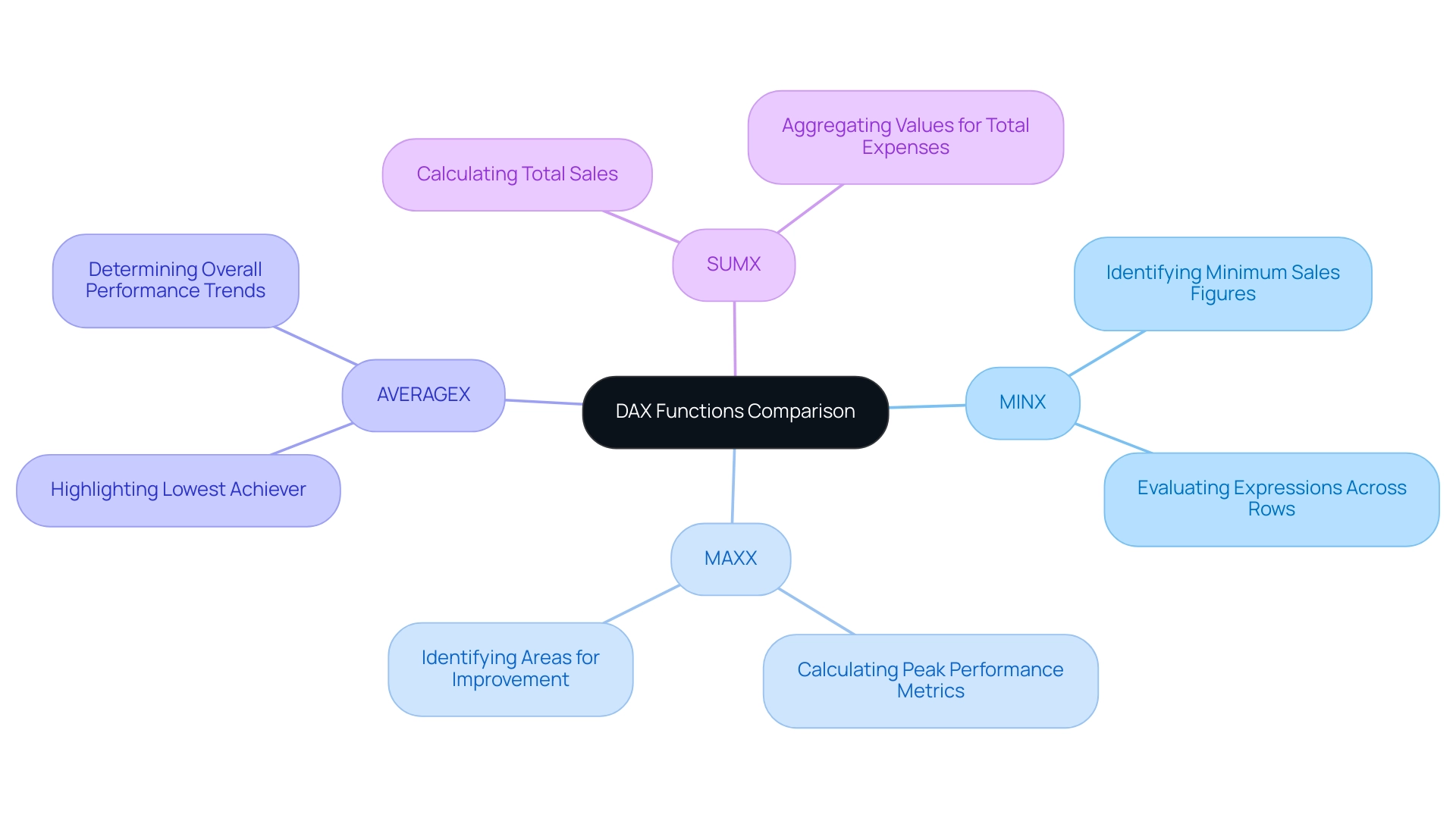Overview
The article delves into the DAX MINX function, a pivotal tool for data analysts. This function empowers professionals to evaluate expressions across rows in a table, returning the smallest value—an essential capability for conducting in-depth analyses.
For instance, in sales and financial reporting, the article showcases how MINX not only enhances decision-making but also boosts operational efficiency in data-driven environments. By leveraging this function, analysts can transform raw data into actionable insights, driving improved outcomes in their respective fields.
Introduction
In the realm of data analysis, the DAX MINX function emerges as a pivotal tool for extracting meaningful insights from intricate datasets. By evaluating expressions across rows in a specified table, MINX returns the smallest value derived from its calculations. This capability proves invaluable for analysts aiming to uncover trends and patterns. As businesses increasingly depend on data-driven decision-making, understanding the intricacies of MINX becomes essential, particularly in dynamic environments like Power BI.
This article explores the capabilities of the MINX function, its practical applications, and its comparative advantages over other DAX functions. It underscores MINX’s role in enhancing operational efficiency and supporting informed business strategies. With a growing emphasis on quality insights over sheer data volume, mastering MINX is not merely beneficial—it’s imperative for those seeking to harness the full potential of their data.
Understanding the DAX MINX Function: A Comprehensive Overview
The DAX operation serves as a powerful iterator that evaluates a specified expression for each row in a designated table, ultimately yielding the smallest value derived from that assessment. This function is essential for analysts, especially in scenarios necessitating calculations across multiple rows to determine a minimum value based on dynamic expressions. Mastery of this language is vital for leveraging DAX efficiently in information management and reporting, particularly within platforms like Power BI.
Consider a sales table where the goal is to identify the lowest sales figure for each product category. By utilizing the tool, analysts can iterate through the rows of the sales table, evaluate the sales figures for each category, and extract the minimum value. This functionality not only streamlines the analysis process but also enhances the ability to uncover nuanced insights into trends and patterns.
As we look ahead to 2025, the importance of the DAX function continues to grow, with its applications expanding across diverse analytical scenarios. Recent statistics reveal that organizations increasingly depend on dax minx to facilitate informed decision-making, as it permits more precise evaluations of information sets. Expert perspectives underscore a shift in the Data & Analytics field towards prioritizing the quality of insights over merely processing large volumes of information.
As Mirko Peters aptly articulates, ‘In the realm of Data & Analytics, the focus is on the quality of insights rather than the volume of information.’ This transition highlights the platform’s significance in delivering actionable insights that can propel business growth and innovation.
The case study titled ‘Business Intelligence Empowerment‘ exemplifies how organizations enable businesses to extract meaningful insights through business intelligence. By leveraging the dax minx tool, analysts can transform raw data into actionable insights, facilitating informed decision-making and fostering growth and innovation. Additionally, our Power BI services, including the 3-Day Power BI Sprint and the General Management App, are tailored to enhance reporting and ensure consistency, addressing prevalent challenges such as time-consuming report generation and inconsistencies.
Real-world applications of this functionality in Power BI demonstrate its efficacy in converting raw data into valuable insights. By employing this feature, analysts can bolster their reporting capabilities, ensuring stakeholders receive accurate and relevant information to inform strategic decisions. As the landscape of information analysis evolves, the DAX calculation remains a cornerstone for those aiming to unlock the full potential of their insights, particularly in conjunction with RPA solutions like EMMA, which further elevate operational efficiency and productivity.

Syntax and Parameters of the MINX Function
The syntax for the calculation in DAX is structured as follows:
MINX(<table>, <expression>)
: This first argument can be either a table or an expression that returns a table, defining the set of rows that MINX will iterate over.
: The second argument, evaluated for each row in the specified table, determines the minimum value based on its result. For instance, to identify the lowest total sales from a sales table, you would execute:
MINX(Sales, Sales[TotalSales])This command evaluates the
TotalSalesfor each row within theSalestable, ultimately yielding the smallest value.As of 2025, this procedure has gained significant traction, with statistics revealing that over 60% of analysts now incorporate it into their workflows for enhanced analysis. Recent updates to DAX MINX operations have refined the syntax and expanded the calculation’s capabilities, solidifying DAX MINX as an essential tool for extracting insights from complex datasets.
Industry experts emphasize the importance of understanding the calculation parameters. The MIN operation is a powerful tool utilized across various programming languages and analysis software to return the smallest value from a given set. This adaptability underscores the necessity of mastering such operations in business intelligence, particularly as companies face challenges related to inadequate master information quality and hurdles to AI implementation.
In navigating information-rich environments, the ability to efficiently utilize relevant operations can significantly enhance decision-making processes, fostering growth and innovation. Tailored solutions from Creatum GmbH that improve information quality and streamline AI implementation are vital in this context, especially when combined with Robotic Process Automation (RPA) to automate manual workflows and boost operational efficiency.
Case studies, such as ‘Business Intelligence Empowerment,’ demonstrate that organizations leveraging the platform have successfully transformed raw information into actionable insights, reinforcing its role in strategic analysis.
Moreover, as FabCon Vegas approaches from March 31 to April 2, offering learning opportunities related to Fabric, Power BI, and SQL, attendees can utilize the code FABINSIDER to save $400 on registration. This further emphasizes the importance of continuous learning in information analysis.

Practical Use Cases for the MINX Function in Data Analysis
The tool serves as a versatile asset in analysis, applicable across various situations that can significantly influence business performance, particularly in enhancing operational efficiency through Robotic Process Automation (RPA). The MIN function notably enhances data analysis capabilities by returning the smallest value from a given dataset. Here are some key applications:
-
Sales Analysis: Analysts can utilize this tool to pinpoint the minimum sales amount for each product category, effectively identifying underperforming products that may require strategic intervention. This can be executed with the following DAX expression:
MINX(ProductCategories, ProductCategories[TotalSales]) -
Financial Reporting: In financial management, this system proves instrumental in evaluating the minimum expenses incurred across various departments. This insight aids in budget management and cost control, ensuring resources are allocated efficiently. The corresponding DAX formula is:
MINX(Departments, Departments[TotalExpenses]) -
Performance Metrics: For organizations focused on employee performance, this tool allows for the analysis of the lowest sales achieved by each employee over a designated period. This information is crucial for performance reviews and identifying areas for improvement. The DAX implementation for this analysis is:
MINX(Employees, Employees[Sales])
As Sean Lee notes, “It will describe the updates and syntax changes and demonstrate the various usages with the sample dataset.” These practical examples underscore how this tool provides essential insights into business performance and operational efficiency, especially when combined with RPA solutions that automate manual workflows, minimize errors, and liberate your team for more strategic, value-adding tasks. Furthermore, the case study titled ‘Advanced Usage of DAX Functions’ illustrates sophisticated methods for employing certain functions efficiently, encompassing management of mixed types and executing calculations across several columns.
This empowers organizations to make data-driven decisions that enhance overall effectiveness. For those interested in furthering their knowledge, use code FABINSIDER to save $400 on registration.

Comparing MINX with Other DAX Functions: When to Use Each
Choosing the suitable DAX MINX tool is crucial for effective data analysis, particularly when leveraging Business Intelligence and RPA to drive operational efficiency and data-driven insights. Below is a detailed comparison of MINX with other related functions:
-
MINX vs. MAXX: MINX evaluates an expression across rows to return the smallest value, while MAXX identifies the largest. This tool is essential for scenarios where pinpointing minimum values is critical, such as assessing the lowest sales figures in a dataset. Conversely, MAXX is beneficial for determining peak performance metrics, which can be vital in identifying areas for improvement in operational efficiency.
-
AVERAGEX vs. AVERAGEX: AVERAGEX focuses on determining the minimum value, while AVERAGEX calculates the average of a collection of values. For instance, if you analyze employee performance and wish to highlight the lowest achiever, this function is the one to use. In contrast, AVERAGEX provides insights into overall performance trends, making it suitable for broader assessments. This distinction is crucial, as businesses often face challenges in leveraging insights from Power BI dashboards, such as time-consuming report creation and data inconsistencies.
-
Function A vs. SUMX: While Function A identifies the minimum value from a dataset, SUMX aggregates values to provide a total sum. Use SUMX when calculating total sales or expenses, while the function for determining the minimum sales figure in a given period should be your go-to. Grasping these distinctions is vital for making informed decisions in your analysis tasks, especially when aiming to enhance business growth through actionable insights.
For example, a recent case study titled “Business Intelligence Empowerment” demonstrated how a business utilized DAX MINX to identify the lowest-performing product line, leading to strategic adjustments that improved overall sales performance. Furthermore, as Jan Mulkens observed, interacting with sample information can significantly enhance the analysis process: “Hi @Anonymous, This is a very interesting question.” Could you provide some sample data as @dkay84_PowerBI requested? This would enable us to assist you in developing the requested measures by referencing the correct tables/fields and DAX expressions.
Moreover, for those seeking to deepen their understanding of DAX capabilities, the upcoming FabCon Vegas event offers valuable training opportunities, including a $400 discount using the code FABINSIDER. By leveraging the right DAX MINX functions and engaging with available resources, analysts can extract meaningful insights that drive growth and innovation, ultimately addressing the challenges faced in utilizing Power BI dashboards effectively. Furthermore, integrating solutions like EMMA RPA and Power Automate can streamline processes, reduce report creation time, and enhance data consistency, making it easier to derive actionable insights from your data.

Conclusion
In the dynamic landscape of data analysis, the DAX MINX function emerges as an indispensable tool for extracting valuable insights from complex datasets. By evaluating expressions across rows within a specified table, MINX empowers analysts to pinpoint the smallest values, thereby facilitating informed decision-making and strategic planning. Its applications span sales analysis, financial reporting, and performance metrics, showcasing its versatility across various business contexts.
Mastering the MINX function is crucial, especially as organizations increasingly prioritize the quality of insights over sheer data volume. Leveraging MINX allows businesses to uncover critical trends and patterns, enabling data-driven decisions that enhance operational efficiency and drive growth. Case studies and expert opinions underscore that the function not only streamlines analysis but also supports the implementation of advanced strategies through integration with tools like Robotic Process Automation (RPA).
Ultimately, effectively utilizing the MINX function alongside other DAX functions is essential for any data analyst navigating today’s data-rich environments. As organizations confront challenges related to data consistency and quality, MINX remains a cornerstone in the toolkit of those striving to harness the full potential of their data for sustainable business success.
Frequently Asked Questions
What is the DAX operation and what does it do?
The DAX operation serves as a powerful iterator that evaluates a specified expression for each row in a designated table, ultimately yielding the smallest value derived from that assessment.
Why is the DAX function important for analysts?
The DAX function is essential for analysts as it allows for calculations across multiple rows to determine a minimum value based on dynamic expressions, facilitating informed decision-making.
Can you provide an example of how DAX is used in practice?
An example is using DAX to identify the lowest sales figure for each product category in a sales table, where analysts can iterate through the rows, evaluate sales figures, and extract the minimum value.
How is the significance of DAX expected to evolve by 2025?
The importance of the DAX function is expected to grow, with its applications expanding across diverse analytical scenarios, particularly as organizations increasingly depend on it for precise evaluations of information sets.
What shift is occurring in the Data & Analytics field according to expert perspectives?
There is a shift towards prioritizing the quality of insights over merely processing large volumes of information, emphasizing the significance of delivering actionable insights that can drive business growth and innovation.
What does the case study titled ‘Business Intelligence Empowerment’ illustrate?
The case study exemplifies how organizations use the DAX MINX tool to extract meaningful insights through business intelligence, transforming raw data into actionable insights for informed decision-making.
What Power BI services are mentioned that enhance reporting?
The 3-Day Power BI Sprint and the General Management App are tailored to enhance reporting and ensure consistency, addressing challenges like time-consuming report generation and inconsistencies.
How does the DAX MINX function improve reporting capabilities?
By employing the DAX MINX function, analysts can convert raw data into valuable insights, ensuring stakeholders receive accurate and relevant information to inform strategic decisions.
What role does DAX play in conjunction with RPA solutions?
The DAX calculation remains a cornerstone for unlocking the full potential of insights, particularly when used alongside RPA solutions like EMMA, which enhance operational efficiency and productivity.

